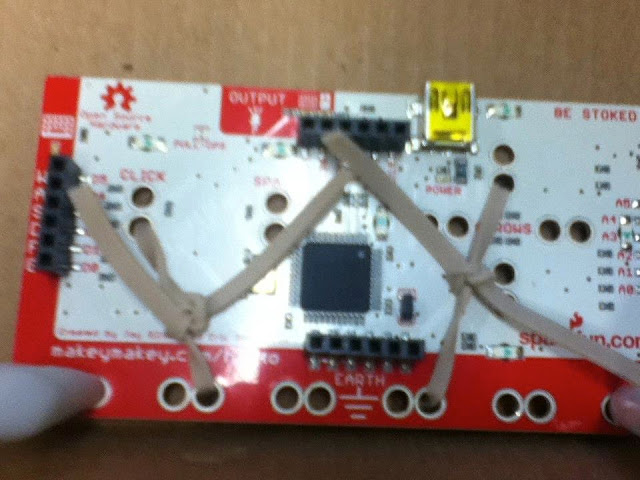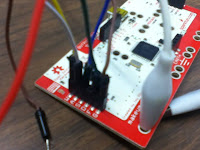***HUGE DISCLAIMER***
There are no patents, trademarks, or the like regarding the MMMK. Feel free to take this design and remix it any way you want. The UML Summer Music Education Research Group dares you to build it better.
_________________________________________________________________________________Here is what you are going to need for the MMMK design:
Materials
- One Arduino-enabled MaKey MaKey board (with box, USB cable, and alligator clips)
- One alligator clip minimum, this MMPC used two
- Arduino cables
- Ten minimum for this design
- Tape
- Two rubber bands
- Conductive tacks
- Aluminum foil
- (Optional conductive paint)
_________________________________________________________________________________
Step One: Download Arduino and the Arduino patch to make your MaKey MaKey work the way that the MMMK wants it to work. In addition, start a Scratch account at scratch.mit.edu and find the MMMK Studio. The Arduino download information and patch are located in the Resources page. Watch Matt's tutorial to get a step by step on this process. For a tutorial on how to get to the MMCB studio in Scratch, watch Graham's tutorial for the step by step.
_________________________________________________________________________________
Step One: Download Arduino and the Arduino patch to make your MaKey MaKey work the way that the MMMK wants it to work. In addition, start a Scratch account at scratch.mit.edu and find the MMMK Studio. The Arduino download information and patch are located in the Resources page. Watch Matt's tutorial to get a step by step on this process. For a tutorial on how to get to the MMCB studio in Scratch, watch Graham's tutorial for the step by step.
_________________________________________________________________________________
Step Two: Use rubber bands to attach the MaKey MaKey into the box. This is one area especially where improvements could be made. Here is what the group came up with. Lay the MaKey MaKey flat in the box (if holding the box open and looking at it head on, the group used right hand corner close to the front of the box). Carefully mark the inside of the four holes shown above (the right hole of the second ground from the left, the right hole of the ground third from the right, the bottom hole of the top arrow trigger, and the bottom hole of the click trigger). Once these are marked, take the MaKey MaKey out of the box and use a box cutter, scissors, or another sharp object to punch small holes through the bottom of the box in the marked spots.
Take your two rubber bands and cut them so they are now just two rubber strips. Thread these strips through the holes. Place the MaKey MaKey back into the box and thread the rubber bands through the same holes that you used to mark reference points. Tie the bands together (triple or quadruple knots should do) to secure the box in place. Refer to the picture above.
_________________________________________________________________________________
Step Three: Get the wiring all set up. Get this step out of the way just to make sure that everything is in order. If you are using the Arduino patch that UML designed, you will want to pay specific attention to the inputs.
_________________________________________________________________________________
Step Four: Arduino wiring time. Strip one end of the wire that will be attached to the tack so that you have a good amount of the inner conductive wire visible. Be prepared to possibly splice some wires to extend lengths. When you finish, each wire should have one end connected to the Arduino ports and one end that is stripped and ready to be attached to a tack.
_________________________________________________________________________________
Step Five: Create the foil contact ground strip. To create the conductive surface on the sides of the MMMK, take your aluminum foil and tear off two sheets approximately 14" by 12" each (other amounts have not been tested, but it has not failed once thus far). Fold these sheets horizontally they less than one inch tall. Open your MaKey MaKey box and observe the slots where the flaps on the top of the box locks into the sides. Take an aluminum foil strip and insert one into each slot as shown above. Use care and be patient, do not mangle the foil.
Take your foil and wrap it around the back of the box as much as you can. Each strip of foil should just barely reach over the opposite side of the box, as shown above.
_________________________________________________________________________________
Step Six: Use tacks to keep the foil in place and act as connection to the MaKey MaKey. When both strips are in place and overlapping each other, pull them so that they are as tight around the box as they can be without damaging structural integrity. Put a tack through the foil and box (this should be about half an inch from the back of the box, at a point where the opposite aluminum foil strip overlaps that side). This will hold the foil in place with no need for adhesive and serve as a connecting point to the alligator clips that connect to ground.
_________________________________________________________________________________
Step Seven: Connect the ground wires to tacks. Attach alligator clips to the outside grounds and connect them up to the tacks holding the aluminum foil. Coiling them as shown above is recommended to save space.
*Note* The Arduino wires were disconnected to show the ground connection with more ease.
_________________________________________________________________________________
Step Eight: Print out the MMMK faceplate from the online template (or create your own) and tack it into place. The template that is linked on the Resources page has dots indicative of where tacks should be placed. This will affix the plate to the board. It is recommended to print it on card stock, this model used basic printer paper. Feel free to customize!
_________________________________________________________________________________
Step Nine: Connect the wires to the tacks to create the triggers. Once one end of a wire is stripped, wrap the inner conductive wiring around the corresponding tack. The blueprints as well as Scratch programming indicates which wires need to be connected to which scale degrees to work as the programming was designed. When you finish making connections, remember to tape down the tops of the wires to hold them in place. It is also recommended that conductive paint be used as a cold solder over the wrapped wiring to both hold the wire to the tack and enforce the connection. When finished, the innards of the MMMK should look like this:
Just close it up and you are ready to go!
Or are you? How can you make this system more cost-effective? More aesthetically pleasing? More functional? The UML Summer Music Education Research Group dares you to make this better. Submit your ideas to us with videos of how you made your version and we will put links so that people can continue to adapt this design and make this system grow more!




















No comments:
Post a Comment